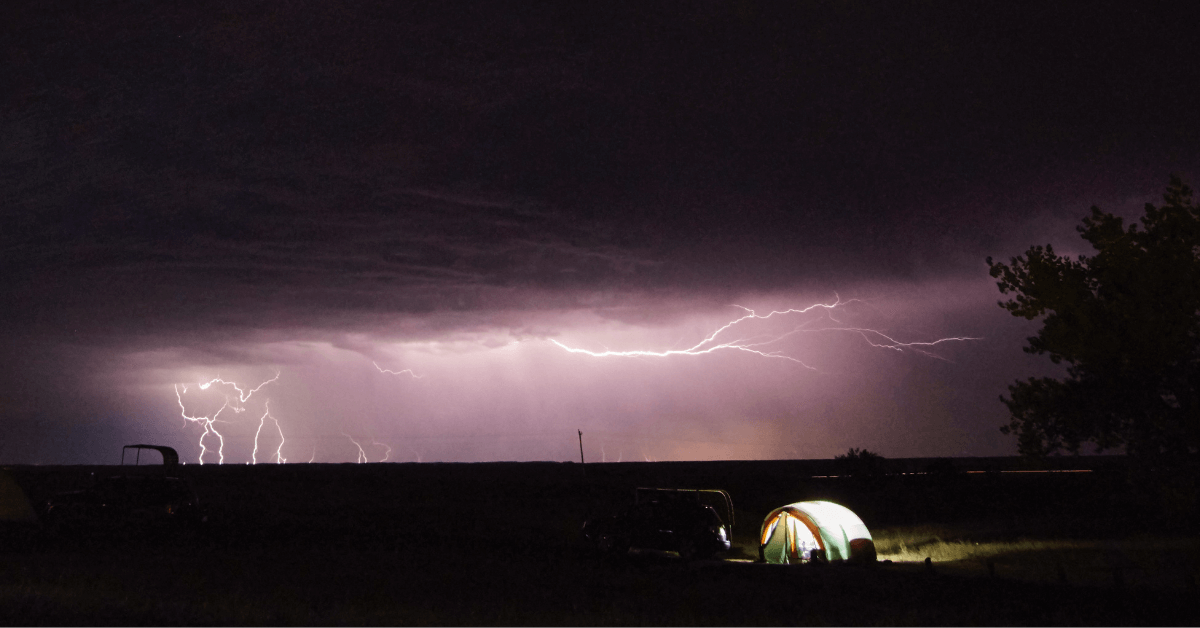Lightning is a powerful and dangerous force of nature that can strike at any time, and when camping or hiking, it’s crucial to know whether or not your shelter can protect you from its wrath. Many people believe that a tent offers protection from lightning, but is this really the case?
In this article, we will explore the question of whether or not lightning can go through a tent and what steps you can take to ensure your safety in a thunderstorm. From the materials used in tents to the proper setup and location, we will cover everything you need to know to make informed decisions about camping in lightning-prone areas.
So, Can Lightning Go Through Tents?
Yes, it is possible for lightning to pass through a tent and the safety of a tent during a lightning storm can vary depending on the materials it is made of and how it is set up. Tents made of metal or with metal components, such as tent poles, are particularly susceptible to conducting electricity. Additionally, a tent that is not properly grounded, such as one set up on a ridge or high point, can also increase the risk of being struck by lightning.
It’s important to note that even a tent made of non-conductive materials, such as nylon, may not provide complete protection from lightning. Therefore, it’s important to be aware of the weather forecast and take appropriate safety measures when camping in an area where thunderstorms are likely.
Understand the nature of the threat that lightning poses
When you camp in a thunderstorm, it is important to understand the nature of the threat that lightning poses to your tent. Fortunately, there are some good tips for protecting yourself from this dangerous and unpredictable weather condition.
One of the best ways to protect yourself from lightning is by staying in a lightning shelter. Lightning shelters are designed to provide protection from getting wet and from lightning.
Another way to ensure your safety during a storm is to stay on the ground. You can do this by laying down in an open field away from scattered trees. For added insulation, you can put on a tarp or sleeping pad.
It’s also a good idea to be aware of what the weather report is predicting. If you hear thunder, you need to run for cover immediately.
In addition, you should know the nature of the “side-splash” phenomenon, which occurs when lightning strikes an object. This is the second most common lightning hazard. During this type of strike, a hopping side flash may occur, which frightens and injures 20 to 30 percent of victims.
One of the best ways to reduce the risk of being struck by lightning is to take the time to check the weather forecast. You can do this by checking the NOAA Weather Radio. They are widely available in many areas where there are no phone lines.
Although lightning is one of the most dangerous natural forces, it is also one of the least studied. Cooper is one of the few people globally who has been studying the effects of lightning on human life. He is motivated to learn more about the effects of lightning on humans and to prevent future injuries.
The National Weather Service has a helpful weather module on its Web site. It is a good idea to sign up for alerts. Likewise, you should keep your cell phone with you at all times. Whether you are camping or out on the water, you should always keep an eye on the sky.
Lightning may be the most dangerous force in the universe, but it is also one of the most awesome. Knowing how to protect yourself from it is one of the best ways to make sure you stay safe while enjoying the great outdoors.
Related: How To Live In A Camper Year-Round
Insulate the ends of your tent poles
Insulating the ends of your tent poles may be an effective method to prevent lightning from going through your tent. However, it is not the only method. Other methods include using a reflective foam to insulate the floor and walls of your tent, or placing a canopy over your tent to reduce icy winds inside your tent.
Besides protecting your tent, there are some other safety tips you should follow if you are going to camp during a thunderstorm. You should avoid touching the ground when in a tent, and try to insulate your tent with the best materials you can afford.
A sleeping bag is a good option for insulation. However, you should be careful not to put your sleeping bag in direct contact with metal. Metal can conduct electricity, and you could get burned. Using a sleeping pad is a better option.
It is also important to keep in mind that lightning is not limited to direct strikes. Ground strikes are also very dangerous. They can cause burns, shocks, and other injuries. Depending on where you are, you might need to move your tent to a safer area.
Another good idea is to bring an air mattress. These can act as a protective layer from the elements, as well as provide insulation from the sun. Alternatively, a small folding camp stool can also serve as an extra layer.
You can even duct tap the interior of your tent to help insulate it. Lastly, a windscreen can help you to mitigate icy winds inside your tent.
In order to insulate your tent with the best possible insulation, you need to keep in mind the three main factors: the temperature, the humidity, and the distance to the nearest conductor. For example, if you are camping in a hot climate, you can use a tarp to insulate the tent from the heat. Likewise, if you are camping in a cold environment, a tent made from reflective foam can reflect the warmth of the sun away from your body.
Getting the most out of your tent is also important. Try to choose a flat, level spot, and don’t forget to bring along a portable snow shovel.
Avoid open buildings

If you are camping, it is advisable to stay away from open buildings or areas. Open buildings and areas are at risk of lightning strikes. Lightning can travel through tents and metal objects.
If you are camping in an area with a lot of trees, you need to be especially careful. The tallest objects, like trees, are at the highest risk of being struck. It is also better to avoid campsites on ridge lines. Getting down to the ground and camping in lower-lying areas is safer.
Another thing to avoid is standing barefoot on concrete or tiled floors. Also, avoid camping on cliffs or water flowing over roads. Be sure to check out your local Bureau of Land Management (BLM) website or local radio station for updates.
During a thunderstorm, be sure to keep your hands in your lap. Never touch any electrical wires or pipes when lightning is overhead. You may be shocked or burnt if a lightning bolt strikes you.
Camping in a car is another option. The vehicle acts as a Faraday cage, preventing electricity from reaching you. However, you should be sure to avoid touching the steering wheel, door handles, and other parts of the vehicle that can conduct electricity.
For added protection, you can also pitch your tent in a low-lying area. There are tents that use carbon fiber poles. These do not have the same impact on your safety as old-school metal poles.
If you are camping in a thunderstorm, you need to be aware of the danger of lightning. This is particularly true if you are in the mountains. Mountainous areas are always a lightning target.
When camping in a thunderstorm, try to avoid places that are susceptible to flooding. Consider putting an extra layer of clothing or a sleeping pad on the floor of your tent. If you do not have a tent, consider a folded camping mat.
Make sure you know how far to a safe place when a storm approaches. You may want to check the Canadian Lightning Danger Map to reduce your chances of being struck by lightning.
Preparing for a storm
In preparing for a storm, you should understand what you are up against. Lightning is a dangerous hazard. If you are in an open area, you should stay calm and take shelter when lightning and thunder appear.
Lightning will attempt to find the quickest route to the ground. For this reason, it is important to avoid open areas and high objects. Tall trees and ridge lines are especially dangerous.
Metal is a good conductor of electricity. This means that metals such as tent poles and zippers can attract lightning. When lightning is overhead, you should move away from these metals.
You should also avoid touching anything that is conductive. Even though tents do not provide protection from lightning, you can take extra precautions. To do this, you can wrap your sleeping bag in a tarp or sit on a stool to increase your insulation.
You should also check the guylines of your tent to ensure that it is secure. Lightning can break through a weak point, which could cause your tent to come down.
Lightning is a severe threat when camping. You should plan your trips ahead of time. Make sure to avoid areas with strong winds and moist conditions.
You should also choose your campsite carefully. Avoid camping on ridgelines or in mountains. These places are more likely to be hit by lightning. Instead, go to a lower location with a dry ravine or depression.
You can also protect yourself from lightning by insulating from the ground. If you are stuck in a thunderstorm, crouch down and try to keep as small a footprint as possible. A foam rubber sleeping pad may be more secure than the ground.
You should also talk with people about how to stay safe during a thunderstorm. Be sure to have an emergency plan in place. It is also a good idea to sign up for local weather alerts.
You should make sure that you have a NOAA Weather Radio. In the event that you don’t have one, you can get weather information from the Internet or a cell phone.
